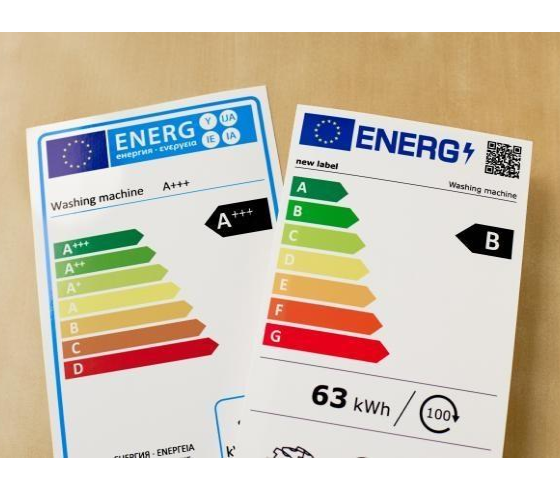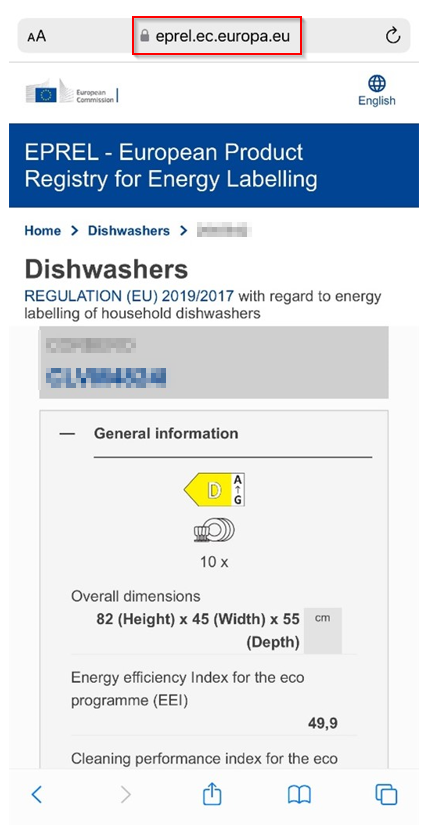First introduced for a number of household appliances in 1994, the EU energy label has been a key driver for helping consumers choose more energy efficient products. At the same time, it encourages manufacturers to innovate and use more efficient technologies.
According to recent Eurobarometer surveys the energy label is well-known by citizens - it is recognised by 93% of consumers and 75% use it to get informed when buying labelled products.
In addition to information about the product’s energy consumption, the labels can also provide supplementary information about other relevant features, such as the product’s noise emissions or water consumption.

Understanding the Energy Label
 |
|
For more information about the different energy labels for each product please consult the Product list page to view each specific product.
Europeans’ attitudes towards EU energy policy
A large majority of respondents say that the European energy label influenced their choice when purchasing an appliance, particularly to save energy and money.
Three quarters of respondents say that in the last five years, the European energy label influenced their choice when purchasing an appliance. This represents a one percentage point increase compared to 2019. Half of all respondents say it influenced their choice of appliance, with their main motivation being to save energy and money, and this is by far the most common answer (50%).
In the last 5 years, has the European Energy Label had an influence on your choice when purchasing an appliance? (EU27) (%)


Read more in the Eurobarometer report (April-May 2024):
- 25 SEPTEMBER 2024
Is scanning the QR code on Energy Labels safe?
The short answer is "YES, if....":
- The QR code leads directly to the official EPREL address, always beginning by ec.europa.eu/: you should see this address on your smartphone (or e.g. tablet) before clicking to reach the linked website (see pictures below)
- The label you scan is on display in shop premises or with a product legally imported and purchased
- The label and the QR code is the original one matching the product (beware e.g. of stickers with a false QR code having been stuck on top of the label. If in doubt, ask the shop staff)
- Beware that EPREL will never ask for any personal data or payment. The only exception is if you are in EPREL and you wish to report an erroneous registration. In this case, EPREL will ask for your email address with the sole purpose to send an email with a link to verify that the error report is not generated by a bot.
By scanning a QR code on a product label, the safe domain of the website (ec.europa.eu) is displayed (here below in yellow). The page you should expect to see on your smartphone looks roughly like the example below:

Via the QR code scanning, you reach the European Product Database for Energy Labelling (EPREL), where you can find more detailed information than what is displayed on the label itself (example: dishwashers):

Generally speaking, scanning QR codes is convenient, but they are increasingly the subject of scams and there are risks to be aware of, such as e.g. malware or phishing.
If in doubt, you can always look up individual products directly using its EPREL identification number via the search function on the EPREL homepage.
Ask the shop staff in case something looks suspicious.
Class arrow and range
In October 2023, the (in full) European Court of Justice issued a pre-judicial ruling with an interpretation of the current EU Energy labelling rules. The Court found that visual advertisement/promotional material should not only include the label rating, but also the relevant range, even for products that are regulated by an “old” labelling delegated act (adopted prior to the 2017 revision of the framework where this requirement was introduced). The Commission considers that the ruling has set a principle that can be applied to all products covered by energy labelling acts adopted under the previous framework.
A new generation of labels
After a generation of labels using classes above A (A+,A++, A+++), it was in 2017 decided to gradually return to a simpler scale with A as the best for the label to remain more understandable to consumers. The revised classes will also be more ambitious in their requirements and thus pave the way for more innovative and energy efficient products. Since 2021, the current energy label with energy classes from A+++ to D are gradually being replaced with a new, simpler scale from A (most efficient) to G (least efficient).
This article, published in 2021, further explains the new generation of EU energy labels.
What are the main changes with the new Energy Efficiency Labels?
The evolution of labels
The images below illustrate the transition of the latest 3 generations of labels for fridges and freezers (note: contrary to the A to G to A+++ to D evolution, no precise mapping of a class into another of the newest label is possible because the parameters and test methods used to classify the performance have evolved).

The history of the label in a timeline
- 1976
First EU measure regarding information on energy use of appliances
- 1979
First Framework Energy Labelling Directive and first EU-designed label
- 1992
First framework for mandatory/EU wide Energy Labelling
- 1994
First EU-designed, mandatory label (refrigerators/freezers)
- 2010
Energy labelling made possible for more energy-related products
- 2017
Current energy labelling framework – product registration in the EU database EPREL became mandatory and the revised A-G scale was introduced
- 2021
QR codes on labels become operational
- 2022
EPREL database search tool available online
Read more about the history of Energy Labelling in the EU
Labels worldwide
The energy label is not only popular in the EU. Variants of it are used in many third countries.
To learn more about appliance standards and labelling programmes worldwide, consult for example the Energy Labels & Standards Analysis IEA.

Guidance for manufacturers and dealers
A guidance note on the label rescaling and transition periods is available since June 2020.
In addition, from 1 January 2019, suppliers (manufacturers, importers or authorised representatives) have to upload information about their products into the European Product Registry for Energy Labelling (EPREL) before placing these products on the European market. Consumers have been able to search the database for energy labels and product information sheets as of March 2021 for the first rescaled product categories.
Read more about the creation, format and printing of the energy label.
- 10 JANUARY 2024
